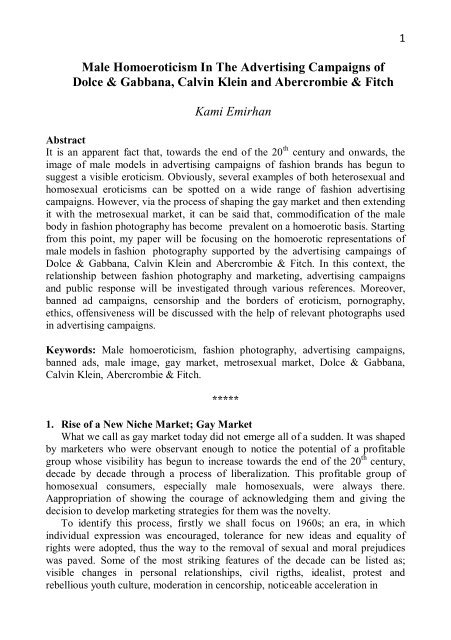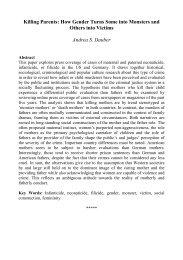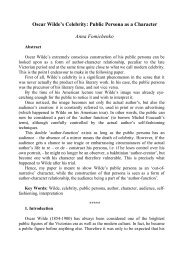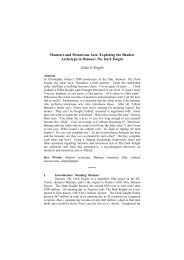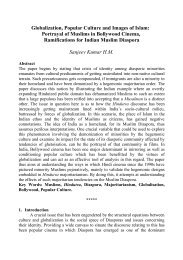Male Homoeroticism In The Advertising Campaigns of Dolce ...
Male Homoeroticism In The Advertising Campaigns of Dolce ...
Male Homoeroticism In The Advertising Campaigns of Dolce ...
Create successful ePaper yourself
Turn your PDF publications into a flip-book with our unique Google optimized e-Paper software.
1<br />
<strong>Male</strong> <strong>Homoeroticism</strong> <strong>In</strong> <strong>The</strong> <strong>Advertising</strong> <strong>Campaigns</strong> <strong>of</strong><br />
<strong>Dolce</strong> & Gabbana, Calvin Klein and Abercrombie & Fitch<br />
Kami Emirhan<br />
Abstract<br />
It is an apparent fact that, towards the end <strong>of</strong> the 20 th century and onwards, the<br />
image <strong>of</strong> male models in advertising campaigns <strong>of</strong> fashion brands has begun to<br />
suggest a visible eroticism. Obviously, several examples <strong>of</strong> both heterosexual and<br />
homosexual eroticisms can be spotted on a wide range <strong>of</strong> fashion advertising<br />
campaigns. However, via the process <strong>of</strong> shaping the gay market and then extending<br />
it with the metrosexual market, it can be said that, commodification <strong>of</strong> the male<br />
body in fashion photography has become prevalent on a homoerotic basis. Starting<br />
from this point, my paper will be focusing on the homoerotic representations <strong>of</strong><br />
male models in fashion photography supported by the advertising campaings <strong>of</strong><br />
<strong>Dolce</strong> & Gabbana, Calvin Klein and Abercrombie & Fitch. <strong>In</strong> this context, the<br />
relationship between fashion photography and marketing, advertising campaigns<br />
and public response will be investigated through various references. Moreover,<br />
banned ad campaigns, censorship and the borders <strong>of</strong> eroticism, pornography,<br />
ethics, <strong>of</strong>fensiveness will be discussed with the help <strong>of</strong> relevant photographs used<br />
in advertising campaigns.<br />
Keywords: <strong>Male</strong> homoeroticism, fashion photography, advertising campaigns,<br />
banned ads, male image, gay market, metrosexual market, <strong>Dolce</strong> & Gabbana,<br />
Calvin Klein, Abercrombie & Fitch.<br />
*****<br />
1. Rise <strong>of</strong> a New Niche Market; Gay Market<br />
What we call as gay market today did not emerge all <strong>of</strong> a sudden. It was shaped<br />
by marketers who were observant enough to notice the potential <strong>of</strong> a pr<strong>of</strong>itable<br />
group whose visibility has begun to increase towards the end <strong>of</strong> the 20 th century,<br />
decade by decade through a process <strong>of</strong> liberalization. This pr<strong>of</strong>itable group <strong>of</strong><br />
homosexual consumers, especially male homosexuals, were always there.<br />
Aappropriation <strong>of</strong> showing the courage <strong>of</strong> acknowledging them and giving the<br />
decision to develop marketing strategies for them was the novelty.<br />
To identify this process, firstly we shall focus on 1960s; an era, in which<br />
individual expression was encouraged, tolerance for new ideas and equality <strong>of</strong><br />
rights were adopted, thus the way to the removal <strong>of</strong> sexual and moral prejudices<br />
was paved. Some <strong>of</strong> the most striking features <strong>of</strong> the decade can be listed as;<br />
visible changes in personal relationships, civil rigths, idealist, protest and<br />
rebellious youth culture, moderation in cencorship, noticeable acceleration in
2<br />
<strong>Male</strong> <strong>Homoeroticism</strong> <strong>In</strong> <strong>The</strong> <strong>Advertising</strong> <strong>Campaigns</strong> <strong>of</strong><br />
<strong>Dolce</strong> & Gabbana, Calvin Klein and Abercrombie & Fitch<br />
consumption, feminism, underground and counter-culture, optimism, gay liberation<br />
etc. Whilst these were all happening simultaneously, most important ones, in the<br />
context <strong>of</strong> formation <strong>of</strong> the gay market, were <strong>of</strong> course counter-culture,<br />
underground, freedom chasers and steps towards gay liberation. Counter-cultural<br />
activities, rooted after the Second World War, were against the technocratic regime<br />
especially in <strong>The</strong> USA and in Europe, and they produced a potentially<br />
revolutionary element in youth. As <strong>The</strong>odore Roszak states;<br />
<strong>In</strong> the technocracy, nothing is any longer small or simple or readily<br />
apparent to the non-technical man. <strong>In</strong>stead the scale and intricacy<br />
<strong>of</strong> all human activities-political, economic, cultural-trancends the<br />
competence <strong>of</strong> the amateurish citizen and inexorably demands the<br />
attention <strong>of</strong> specially trained experts. 1<br />
<strong>In</strong> conjunction with this explanation, Roszak also mentions about a salient<br />
outcome <strong>of</strong> these counter-cultural activities as;<br />
... one <strong>of</strong> the most remarkable aspects <strong>of</strong> the counter culture is its<br />
cultivation <strong>of</strong> a feminine s<strong>of</strong>tness among its males. It is the<br />
occasion <strong>of</strong> endless satire on the part <strong>of</strong> critics, but the style is<br />
clearly a deliberate effort on the part <strong>of</strong> the young to undercut the<br />
crude and compulsive he-manliness <strong>of</strong> American political life. 2<br />
Based on this statement it seems quite possible to say that, by the help <strong>of</strong><br />
counter-culture, not only the stiff, rigid structure <strong>of</strong> the western society began to<br />
come apart, but also males <strong>of</strong> this society began to become s<strong>of</strong>ter. This s<strong>of</strong>tness<br />
opened the way to accept the unacceptables more easily and coherently worked as<br />
a gadget for the freedom chasers on their goals.<br />
At this point we shall speak <strong>of</strong> gay liberation. Gay subculture was still<br />
underground in 1950s but small groups <strong>of</strong> organizations and magazines were being<br />
formed in a sense <strong>of</strong> closed communication. <strong>In</strong> the following years, student<br />
committees, fronts, and communities began to add up to these organizations<br />
fighting for dignity and equality. Towards the end <strong>of</strong> 1960s, as a result <strong>of</strong><br />
convergences, resistence to opression became inevitable and ocular, which Martin<br />
Duberman describes as;<br />
Resistence to opression, takes place on the confident form <strong>of</strong><br />
political organizing only after a certain critical mass <strong>of</strong> collective<br />
awareness <strong>of</strong> opression, and a determination to end it, has been<br />
reached. 3
3<br />
Kami Emirhan<br />
Probably the most monumentalized resistence is remembered as Stonewall. A<br />
gay bar in New York’s Greenwich Village area, Stonewall <strong>In</strong>n. <strong>In</strong> the summer <strong>of</strong><br />
1969, a usual police raid was resisted by the frequenters <strong>of</strong> the bar which was new<br />
and unusual. This resistence, started against the corrupt Mafia-Police relations,<br />
transformed itself to become a milestone in the history <strong>of</strong> gay liberation. <strong>In</strong> the<br />
meaning <strong>of</strong> gay rights, gay cause, self-expression and visibility, it triggered an<br />
atmosphere <strong>of</strong> self reliance which played an important role in gay movement<br />
throughout the 1970s and 1980s.<br />
After all the achievements <strong>of</strong> the gay movement, it did not take too long for<br />
marketers, advertisers and brands to spot this visibility and to designate it as a new<br />
pr<strong>of</strong>itable segment. Market researches and trade press coverages began to be made.<br />
<strong>In</strong> the late 1980s and early 1990s shaping <strong>of</strong> gay market reached its maturity. Of<br />
course in this process, both out and proud and in the closet gay marketers, gay<br />
publishers, gay designers, gay artists, gay photographers, gay singers, gay actors<br />
and gay company owners worked in chorus, not necessarily consciously. Gay tv<br />
channels bagan to appear, gay websites began to <strong>of</strong>fer dates, gay magazines<br />
became prevalent, gay tv programmes began to be presented, gay tv series began to<br />
be produced. All these, provided a wide range <strong>of</strong> venue for advertisement.<br />
2. Extending <strong>The</strong> Gay Market; Metrosexual Market<br />
As the gay market was shaped successfully, it needed to be extended in order to<br />
reach more men, who were not necessarily gay. Heterosexual men too were needed<br />
to be urged to shop, thus came the metrosexual market. <strong>The</strong> word metrosexual first<br />
appeared in print media in an essay <strong>of</strong> Mark Simpson, entitled: Here Come <strong>The</strong><br />
Mirror Men: Why <strong>The</strong> Future is Metrosexual, in <strong>The</strong> <strong>In</strong>dependent on 15/11/1994. 4<br />
<strong>In</strong> this essay, Simpson describes the metrosexual as;<br />
Metrosexual man, the single young man with a high disposable<br />
income, living or working in the city (because that’s where all the<br />
best shops are), is perhaps the most promising consumer market <strong>of</strong><br />
the decade. <strong>In</strong> the Eighties he was only to be found inside fashion<br />
magazines such as GQ, in television advertisements for Levis<br />
jeans or in gay bars. <strong>In</strong> the Nineties, he’s everywhere and he’s<br />
going shopping. 5<br />
Simpson, sees the metrosexual man as the creation <strong>of</strong> capitalism’s voracious<br />
appetite for new markets and he states that ‘metrosexual man contradicts the basic<br />
premise <strong>of</strong> heterosexuality – that only women are looked at and only men do the<br />
looking. Metrosexual man might prefer women, he might prefer men, but when<br />
all’s said and done nothing comes between him and his reflection.’ 6 Simpson<br />
clinches his point in one <strong>of</strong> his articles written for Salon readers by saying ‘... to
4<br />
<strong>Male</strong> <strong>Homoeroticism</strong> <strong>In</strong> <strong>The</strong> <strong>Advertising</strong> <strong>Campaigns</strong> <strong>of</strong><br />
<strong>Dolce</strong> & Gabbana, Calvin Klein and Abercrombie & Fitch<br />
determine a metrosexual, all you have to do is look at them. <strong>In</strong> fact, if you’re<br />
looking at them, they’re almost certainly metrosexual.’ 7<br />
It seems that according to Mark Simpson, David Beckham, a man who has<br />
confirmed to be straight and has indicated that he liked to be admired and didn’t<br />
care whether this admiration was done by women or men, exhibits a good example<br />
for the metrosexual man. 8 Beckham, back in late 1990s and early 2000s, wearing<br />
his wife’s sarongs and panties and having his nails done with pink nail polish,<br />
changing his haircut frequently, showing himself on advertisements and in fashion<br />
spreads seminaked, is indeed a good example.<br />
With the metrosexual defined, or maybe even before, came the skincare<br />
products, cosmetic products marketed directly to men. More men started to attend<br />
hair removal and grooming salons. What metrosexuality began to refer to, from<br />
that point on is actully; ‘the life <strong>of</strong> a heterosexual man who has taken on more<br />
predominate feminine characteristics, which are stereotypically associated with<br />
homosexuality.’ 9<br />
Via selling the queer style, not only the drawback <strong>of</strong> being regarded as<br />
homosexual among heterosexual males who craved for being admired was<br />
revomed by a kind <strong>of</strong> commercial masculinity, but also gay market was extended<br />
with the metrosexual market.<br />
... metrosexuality as deployed on US popular culture assuaged and<br />
managed anxieties relevant to the threat <strong>of</strong> feminisation and<br />
homosexualisation <strong>of</strong> men posed by commercial masculinity by<br />
foregrounding and organizing homosociality in strategic ways. 10<br />
Metrosexuality invited the appropriation <strong>of</strong> feminine and stereotypic gay<br />
aspects <strong>of</strong> self-presentation styles by heterosexual males and this appropriation <strong>of</strong><br />
course, at the end <strong>of</strong> the day, resulted in lifting the effectiveness <strong>of</strong> gay consumer.<br />
Thus came the wide acceptance <strong>of</strong> gay consumer.<br />
Consecutivly, by the help <strong>of</strong> this commercial masculinity, objectification <strong>of</strong> the<br />
male body became prevalent in fashion photography, fashion spreads and<br />
advertisement campaigns <strong>of</strong> most fashion brands. This objectification, especially<br />
in recent years, began to be approached with a homosocial manner, urging<br />
designers, stylists, and photographers to present men in homoerotic mise en scenes<br />
more explicitly.
5<br />
Kami Emirhan<br />
3. Homoerotic Presentations <strong>of</strong> Men in <strong>The</strong> Advertisement <strong>Campaigns</strong> <strong>of</strong><br />
<strong>Dolce</strong> & Gabbana, Calvin Klein and Abercrombie & Fitch<br />
Image 1. An Advertisement Campaign <strong>of</strong> <strong>Dolce</strong> & Gabbana 11<br />
<strong>In</strong> the advertisement campaign <strong>of</strong> <strong>Dolce</strong> & Gabbana (D&G) seen above,<br />
suggestions <strong>of</strong> male homoeroticism is quite obvious. On the right side <strong>of</strong> the photo;<br />
in the front, there’s a totally nude man lying on his back, eyes closed, mouth half<br />
open, hands on his body. This nude figure seems to be exhibiting his indulgence <strong>of</strong><br />
being watched via delighting the two watchers on the back. <strong>The</strong> older one <strong>of</strong> the<br />
watchers on the far right, is pointing at with his finger presumably the genital area<br />
<strong>of</strong> the lying figure, lifting the effectiveness <strong>of</strong> spectatorship. At the same time, we<br />
see two men on the left side <strong>of</strong> the photo, where the one in the back is either doing<br />
or undoing his tie, and the one in the front is either zipping or unzipping his zipper.<br />
<strong>In</strong> both cases, regarding the overall view, these figures on the left are <strong>of</strong>fering a<br />
scene where a sexual intercourse is about to begin or has newly finished.<br />
With all the figures in the photo, through positioning men in a homoerotic mise<br />
en scene, the spectator <strong>of</strong> the ad, who is supposed to be a man, is encouraged to<br />
fantasize himself in this gathering. This most probably homosexual male spectator<br />
is urged both to watch the watchers and the strippers in a voyeuristic manner and
6<br />
<strong>Male</strong> <strong>Homoeroticism</strong> <strong>In</strong> <strong>The</strong> <strong>Advertising</strong> <strong>Campaigns</strong> <strong>of</strong><br />
<strong>Dolce</strong> & Gabbana, Calvin Klein and Abercrombie & Fitch<br />
go for shopping happily. <strong>In</strong> this campaign, eye catcher role is played by the<br />
shocking tactic, which advertisement itself is supposedly based on.<br />
Image 2. An Advertisement Campaign <strong>of</strong> Calvin Klein 12<br />
Not always the homoerotic presentation is <strong>of</strong>fered with more than one figure.<br />
As seen in the advertisement campaign <strong>of</strong> Calvin Klein (CK) above, just one<br />
figure, not even fully naked, may very well be enough to emphasize<br />
homoeroticism. <strong>In</strong> this case, the spectator is exposed to two images <strong>of</strong> the same<br />
man, shot from two different angles. While the figure shown on the right is<br />
presented fully clothed with a suit, t-shirt and sunglasses, the one on the left is<br />
exhibited with a seductive approach, where he is seen either pulling his trousers<br />
down or pulling it on, apparently wearing no underwear. Another aspect <strong>of</strong> the shot<br />
on the left, apart from the seminaked body <strong>of</strong> the man focusing the homoerotic<br />
gaze on himself, is that; the rising <strong>of</strong> the fly button part <strong>of</strong> the trouser, intentionally<br />
or unintentionally, suggesting a phallic display.<br />
Again in this advertisement campaign, the spectating male consumer is urged to<br />
go for shopping via associating himself with the beauty and seductivness <strong>of</strong> the<br />
male body, as if that is the commodity sold in CK’s stores, not apparel. Hereby, the<br />
brand’s and the marketer’s target is reached.
7<br />
Kami Emirhan<br />
Image 3. A Still From <strong>The</strong> Video ‘Other Sports Require One Ball. Wrestling<br />
Requires Two’, Shot For Abercrombie & Fitch, By Bruce Weber 13<br />
Image 4. A Still From <strong>The</strong> Video ‘Other Sports Require One Ball. Wrestling<br />
Requires Two’, Shot For Abercrombie & Fitch, By Bruce Weber 14
8<br />
<strong>Male</strong> <strong>Homoeroticism</strong> <strong>In</strong> <strong>The</strong> <strong>Advertising</strong> <strong>Campaigns</strong> <strong>of</strong><br />
<strong>Dolce</strong> & Gabbana, Calvin Klein and Abercrombie & Fitch<br />
<strong>In</strong>ternationally appreciated photographer Bruce Weber, shot four short videos<br />
for Abercrombie & Fitch (A&F) in 2012. <strong>In</strong> this series <strong>of</strong> videos evolving around<br />
wrestling men, the most pretentious shooting is the one with the title ‘Other Sports<br />
Require One Ball. Wrestling Requires Two’. <strong>In</strong> the first still from this video shown<br />
in Image 3, two men are seen in shower, wrestling, one held by the other whilst<br />
supporting himself with his legs on the walls <strong>of</strong> the shower. <strong>The</strong> figure, who does<br />
the holding, seems to be exhibiting a look <strong>of</strong> ecstasy, which may quite possibly<br />
<strong>of</strong>fer to the spectator a perception <strong>of</strong> pleasure, taken presumably from a sexual<br />
intercourse.<br />
<strong>In</strong> the second still shown in image 4, we see the same two men in latter seconds<br />
<strong>of</strong> the video, with the one who was being held kissing the other on the forehead.<br />
Here, it seems quite possible to say that, although this kissing may naively be a<br />
friendly gesture, under the homoerotic circumstances <strong>of</strong> wrestling itself and<br />
regarding the previous image, it may also be a thank you for the great sex we just<br />
had kiss.<br />
<strong>Homoeroticism</strong>, distinctly suggested in the stills above, is again the part <strong>of</strong> a<br />
strategy based on catching the eye <strong>of</strong> gay consumer.<br />
4. Conclusion<br />
Shaping the gay market along with the gay liberation and expanding it with the<br />
metrosexual market in conjunction with the freeing <strong>of</strong> self-admired male, have<br />
brought us today to such a pretentious level on presentation <strong>of</strong> the male image that<br />
it had never been before. Essentially, this assertive approach is based on the<br />
commodification <strong>of</strong> male body, but marketing the product via presenting this<br />
commodification in a notably homoerotic manner is obviously a challenge to a<br />
heteronormative society.<br />
Whilst this challenge is due to the rise in the visibility <strong>of</strong> homosexual and<br />
metrosexual man, it basically bases on an understanding <strong>of</strong> ‘Body sells. Beauty<br />
sells. Eroticism sells.’ 15 Thus, especially in recent years, male homoeroticism in<br />
the advertisement campaigns <strong>of</strong> most brands, has become one <strong>of</strong> the determinative<br />
key aspects <strong>of</strong> marketing strategies.<br />
<strong>The</strong> level <strong>of</strong> homoeroticism in advertisement campaigns forcing the boundries<br />
<strong>of</strong> pornography, perception <strong>of</strong> this homoeroticism by public, the role <strong>of</strong> censorship<br />
on these campaigns and banned ads could not be discussed in this study due to<br />
predesignated space <strong>of</strong> the chapter and are subjetcs to a further reading.
9<br />
Kami Emirhan<br />
Notes<br />
1<br />
<strong>The</strong>odore Roszak, <strong>The</strong> Making <strong>of</strong> A Counter Culture; Reflections on <strong>The</strong><br />
Technocratic Society and Its Youthful Opposition (New York: Anchor Books,<br />
1969), 6.<br />
2 Ibid, 74.<br />
3 Martin Duberman, Stonewall (New York: Plume, 1993), 75.<br />
4 Here Come <strong>The</strong> Mirror Men: Why <strong>The</strong> Future is Metrosexual, By Mark Simpson,<br />
Last Viewed 10 April 2013,<br />
http://www.marksimpson.com/here-come-the-mirror-men/<br />
5 Ibid.<br />
6 Ibid.<br />
7 Meet <strong>The</strong> Metrosexual, By Mark Simpson,<br />
Last Modified 22 July 2002, Last Viewed 10 April 2013,<br />
http://www.salon.com/2002/07/22/metrosexual/<br />
8 Ibid.<br />
9 Michael J. Yaksich, Consuming Queer: Buying Style or Acceptance (American<br />
Sociological Association Annual Meeting, San Francisco, 2004), 2.<br />
10<br />
Helene Shugart, Managing Masculinities: <strong>The</strong> Metrosexual Moment<br />
(Communication and Critical/Cultural Studies, Vol.5, No.3, September 2008), 287.<br />
11 Last Modified 23 September 2010, Last Viewed 10 April 2013,<br />
http://saviourxxx.blogspot.com/2010/09/d-campains-story-part-3.html<br />
12 Last Modified 5 August 2012, Last Viewed 10 April 2013,<br />
http://www.fashionindie.com/post/speechless-calvin-klein-mens-ad-campaign<br />
13 Last Modified 29 April 2012, Last Viewded 10 April 2013,<br />
http://kontraplan.com/site/2012/04/29/bruce-weber-wrestling-requires-two-balls/<br />
14 Ibid.<br />
15 Jean Baudrillard, La Société De Consommation, trans. Hazal Deliceçaylı, Ferda<br />
Keskin (Istanbul: Ayrıntı, 2012), 157.<br />
Bibliography<br />
Baudrillard, Jean. La Société De Consommation, trans. Hazal Deliceçaylı, Ferda<br />
Keskin, Istanbul: Ayrıntı, 2012.<br />
Duberman, Martin. Stonewall, New York: Plume, 1993.<br />
Marwick, Arthur. <strong>The</strong> Sixties: Cultural Revolution in Britain, France, Italy, and<br />
the United States, c.1958-c.1974., New York: Oxford University Press, 1998.
10<br />
<strong>Male</strong> <strong>Homoeroticism</strong> <strong>In</strong> <strong>The</strong> <strong>Advertising</strong> <strong>Campaigns</strong> <strong>of</strong><br />
<strong>Dolce</strong> & Gabbana, Calvin Klein and Abercrombie & Fitch<br />
Roszak, <strong>The</strong>odore. <strong>The</strong> Making <strong>of</strong> a Counter Culture: Reflections on the<br />
Technocratic Society and Its Youthful Opposition, New York: Anchor Books,<br />
1969.<br />
Sender, Katherine. Business, Not Politics: <strong>The</strong> Making <strong>of</strong> <strong>The</strong> Gay Market, New<br />
York: Columbia University Press, 2004.<br />
Shugart, Helen. Managing Masculinities: <strong>The</strong> Metrosexual Moment,<br />
Communication and Critical/Cultural Studies, Vol.5, No.3, September 2008.<br />
Simpson, Mark. <strong>Male</strong> Impersonators, London: Cassel, 1994.<br />
Yaksich, Michael J. Consuming Queer: Buying Style or Acceptance, American<br />
Sociological Association Annual Meeting, San Francisco, 2004.<br />
Here Come <strong>The</strong> Mirror Men: Why <strong>The</strong> Future is Metrosexual, By Mark Simpson,<br />
Last Viewed 10 April 2013,<br />
http://www.marksimpson.com/here-come-the-mirror-men/<br />
Meet <strong>The</strong> Metrosexual, By Mark Simpson,<br />
Last Modified 22 July 2002, Last Viewed 10 April 2013,<br />
http://www.salon.com/2002/07/22/metrosexual/<br />
Last Modified 23 September 2010, Last Viewed 10 April 2013,<br />
http://saviourxxx.blogspot.com/2010/09/d-campains-story-part-3.html<br />
Last Modified 5 August 2012, Last Viewed 10 April 2013,<br />
http://www.fashionindie.com/post/speechless-calvin-klein-mens-ad-campaign<br />
Last Modified 29 April 2012, Last Viewded 10 April 2013,<br />
http://kontraplan.com/site/2012/04/29/bruce-weber-wrestling-requires-two-balls/<br />
Kami Emirhan is a Research Assistant at the Department <strong>of</strong> Fashion and Textile<br />
Design within the Faculty <strong>of</strong> Fine Arts at Yeditepe University in Istanbul. While<br />
specializing on print/surface design, currently he is focused on homosocial<br />
presentations <strong>of</strong> the male image in fashion photography.


